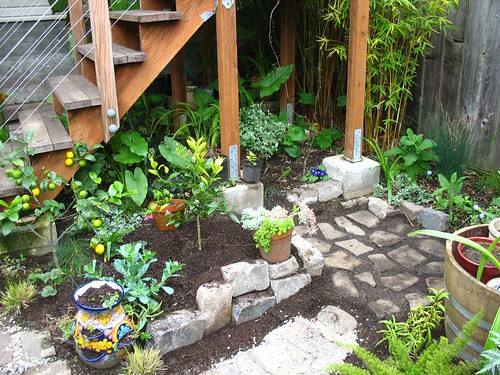
I finally found a way to use that Connecticut blue flagstone water-wash I bought for a project I aborted one week after starting--a fountain, stream, and waterfall if you can believe that. "Those landscape construction books make everything look so easy." My boyfriend got real tired of hearing that refrain.
And, it's always nice to use the dreaded clay soil... I mixed it 1:1 with a commercially available chicken manure-based soil amendment (hardly transforming the texture of the clay soil at all) and secured the mini-flagstones. When the ground warms up, I'll sow Thymus vulgaris to grow between the rocks. Until then, I sprinkled California poppy--indestructible, and always guaranteed. I tested to make sure chair legs could find easy purchase on level stone. That worked, so this should be a nice place to sit.
Elsewhere...
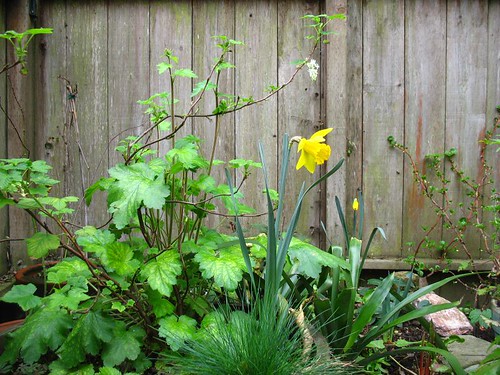
I'm pretty sure when you buy a bag of mixed bulbs, it's always a bagful of the most boring variety.
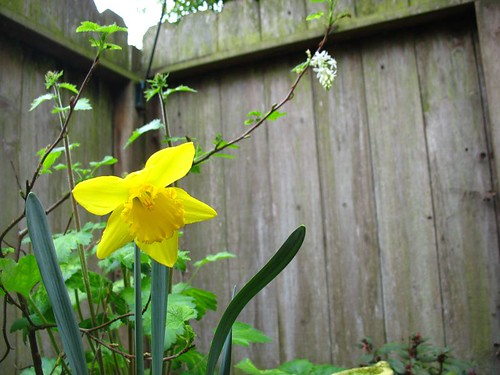
I know this shade bed looks hectic in pictures, but it's one of my favorite spots in the garden.
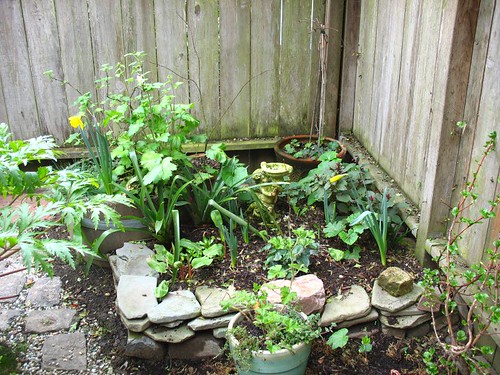
I have the Ribies sanguineum 'Inverness White' in the barrel with Heuchera, and Satureja douglasii. In the bed, Acer circinatum (young/small, and barely visible as a twig crossing through the top of that white statue (formerly my grandmother's), two bromeliads given to me by a gardener at the Bot Garden, Gaultheria shallon, Anemopsis californica, and cineraria. In the back, a potted Acer palmatum (some cultivar name I don't remember) and more of the Ampelopsis brevipedunculata I showed you last week.
I'm eager for the climbing hydrangea to get some altitude. I'll put a nice bench there where the Nolina is currently parked. No idea what I'm going to do with the Nolina. Maybe donate it to the Botanical Garden.
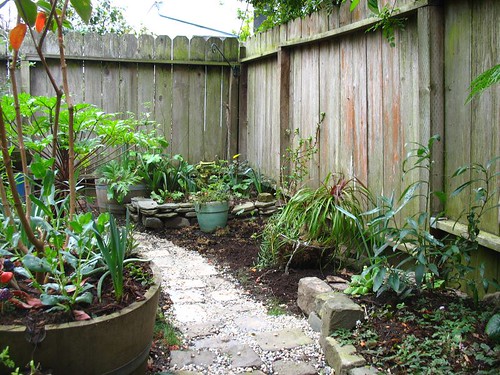
Checking in with the Fuchsia...looking good. I need more non-green in my garden. Especially in this bed.

Bartlettina sordida, blooming soon. Then I'll have to really cut it back. That plant grows fast after the flower.
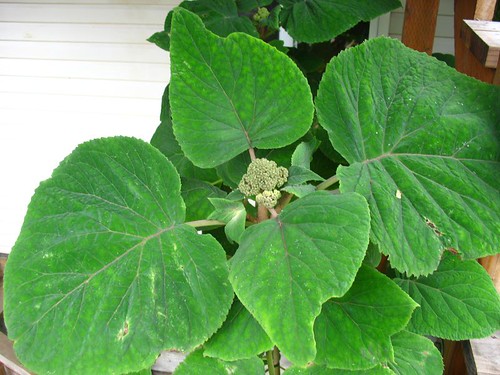
It's supposed to be easy to propagate so I'm trying just for the hell of it.

(Yes, there's some vermiculite under the perlite. It's just topped-off with perlite because I wanted to finish the bag.)
This Salvia clevelandii is easy to propagate too.

Unlike the Bartlettina, I could probably squeeze another one of these in somewhere. This is the most fabulously fragrant sage ever. Native to southern California and northern Mexico. An obnoxiously brittle plant! I can't seem to walk by it without breaking it. Which is how I got material for these cuttings.
What's up in the garage? Among other things, one of six pumpkins, two of six butternuts, four of six Datura wrightii. Next year I'll start tomatoes a month earlier. (Assuming this year's harvest goes well.)
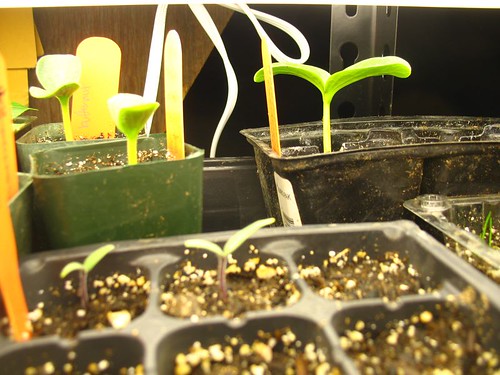
Another native shade bed. This one's all northern California natives, and that's a north-facing wall. (My neighbor's house, in fact.) Leafing out, Calycanthus occidentalis. You see the Carolina allspice more often in the nursery trade.
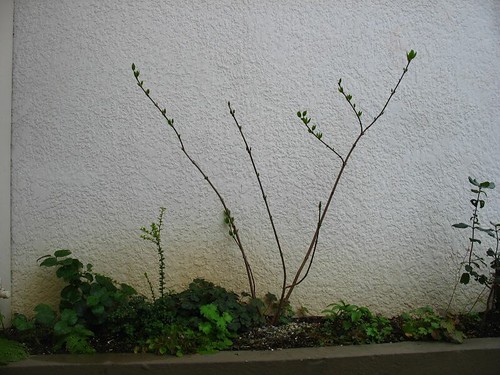
I pruned it a couple weeks ago. What do you think? It was congested, so I reduced it to three branched canes. I guess we'll just have to wait and see.
On the front porch, succulents and sweet peas...

And St. Catherine's Lace (Eriogonum giganteum), a buckwheat native to the islands off the coast of southern California.

It's a good plant for butterflies and bees.
I want some kind of vine that will cling to the house in this pot.
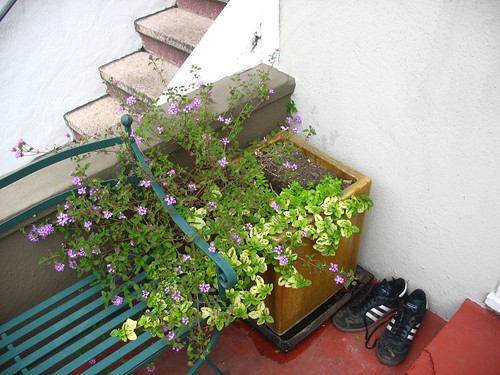
Did I really garden in my Adidas? Yes, I did. I spent the whole time thinking I shouldn't be doing that.

8 comments:
Are there any other requirements for this house clinging vine?
That's an excellent question. The key question, really.
Well, it needs to take heat and full sun. An annual would probably be ideal because I don't want it to get out of control. It would be good if it didn't rip paint off the stucco when it comes down. Flowers and/or fragrance are always nice. It should look nice against a white background because the house is white. And of course it has to be happy in a pot.
Do you have thoughts?
Would you consider putting white painted screws into the wall and running clear fishing line between them about 1 to 2 inches above the wall surface up to the height you want this vine to grow? That will greatly expand your options.
Love that pink (?) Aeonium (?) in the succulent planter. Do you know what it is?
Christopher will have better thoughts than I, except: anything that will cling to stucco will damage stucco.
It will probably be too cliche for you, but I still think bouganvillea and stucco were made for each other. I think it will handle the pot ok, and it will love the heat.
I'm not thrilled about putting screws in my stucco. I think the b.f. would reject that idea too. Too bad, huh.
That pot's too close to the front door for thorny bouganvillea, and bouganvillea needs support too, n'est-pas?
Pink, purple, the color of that succulent varies. While I can occasionally recall the name, at the present moment I cannot. Would you like a piece? E-mail me your address and I'll send you some. You'll have tons of it by mid-summer. It makes a cool flower too that looks good even when it's dead. I took a cutting of that plant from the last place I lived.
Bougainvillea Hate It!
mmw is correct. Anything that will attach to stucco will damage it and some of the best attachers like shade.
One lousy screw at the top of the wall will cause less harm.
Do you have house numbers, porch lights, rain gutters or any other items screwed into your stucco?
Speaking of bees, have you read that honeybees are now missing from 24 states? Also, this winter in Illinois outside of Chicago, I haven't seen one Blue Jay, while every other year they're eating at the birdfeeder in my back yard in abundance. Not even one. They're very susceptible to West Nile virus. This is a horrible shame. What's going on here??
Of course you hate bougainvillea, Christopher, you live in Hawaii. For those of us who grew up in zone 6, though, it still has some of that totemic subtropical magic.
One thing you could do, Chuck, is rig up some kind of trellis attached to the container, not the wall. It will be tough to get enough scale unless you have a really big container.
Post a Comment